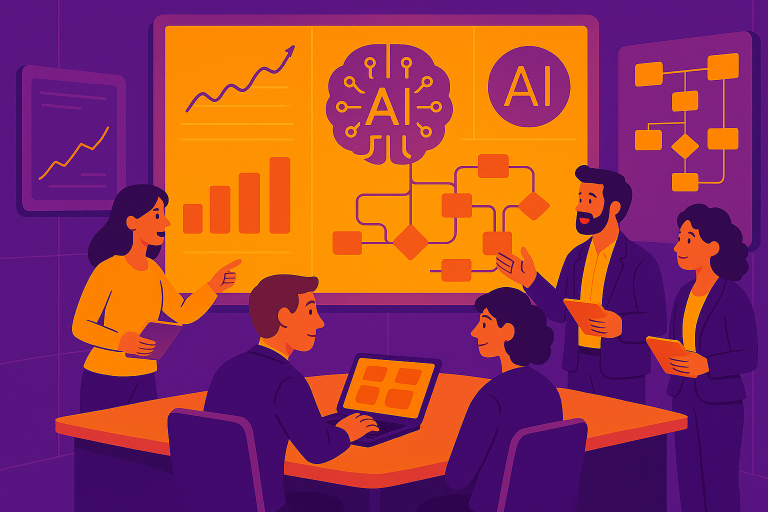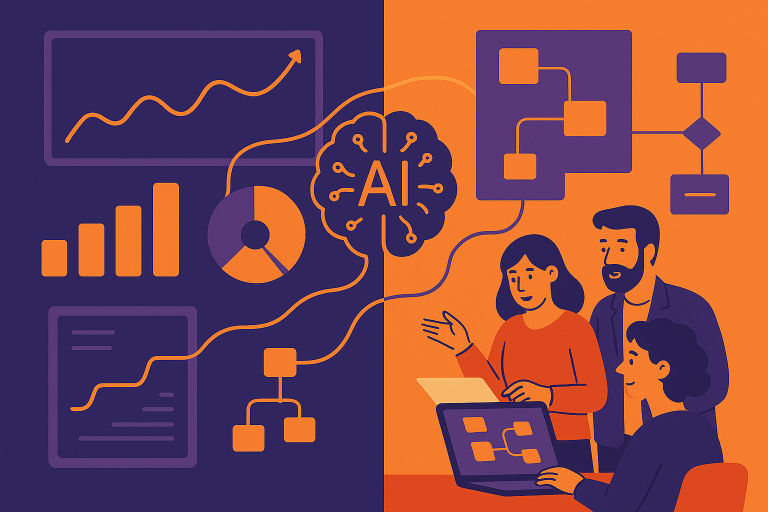Collaborative AI Workflows: Teams and Machines Working Together
In today’s rapidly evolving technological landscape, the relationship between humans and artificial intelligence has progressed far beyond the initial concept of machines simply replacing human labor. Instead, we’re witnessing the emergence of something far more powerful and nuanced: collaborative AI workflows that blend the unique strengths of both humans and machines. This synergy is creating unprecedented opportunities for innovation, productivity, and problem-solving across industries.
The most forward-thinking organizations aren’t asking whether AI will replace their teams—they’re discovering how AI can enhance their teams’ capabilities, accelerate outcomes, and transform what’s possible. Let’s explore how your organization can harness the power of collaborative AI workflows to achieve remarkable results.

Understanding Collaborative AI Workflows
Before implementing collaborative AI workflows in your organization, it’s essential to understand what they are and how they function at their best. This foundation will help you build systems that truly amplify human capabilities rather than simply automating existing processes.
Definition and Core Principles
Collaborative AI workflows represent a symbiotic approach where humans and AI systems work together, each contributing their unique strengths to achieve outcomes neither could accomplish alone. Unlike traditional automation that simply executes predefined tasks, collaborative AI participates as an active partner in complex processes.
The evolution from automation to collaboration marks a significant shift in how we think about AI implementation:
- Automation era: AI replaces routine, repetitive human tasks
- Augmentation era: AI enhances human capabilities in specific domains
- Collaboration era: Humans and AI become interdependent partners, with fluid exchange of ideas, feedback, and decision-making
The most effective collaborative AI workflows adhere to these core principles:
- Complementary strengths – AI excels at processing vast data sets, pattern recognition, and consistency; humans bring creativity, ethical judgment, contextual understanding, and emotional intelligence
- Adaptive interaction – The division of labor between human and AI adjusts dynamically based on the specific task, context, and expertise levels
- Continuous learning – Both the AI system and human teams improve through ongoing interaction and feedback
- Shared goals – Clear alignment on objectives ensures both human and AI components work toward common outcomes
Benefits of Human-AI Collaboration
When properly implemented, collaborative AI workflows deliver substantial benefits that purely human or purely automated approaches cannot match. Integrating AI into your product lifecycle management and team workflows can transform your business outcomes in several key ways:
| Benefit Category | Specific Advantages | Real-World Impact |
|---|---|---|
| Enhanced Decision-Making | Reduction in cognitive bias, expanded analysis scope, data-backed intuition | 20-35% improvement in decision quality across management levels |
| Productivity Gains | Faster task completion, reduced busywork, focus on high-value activities | 30-50% time savings on complex knowledge work |
| Quality Improvements | Error detection, consistency enforcement, comprehensive validation | 40-60% reduction in critical errors in regulated processes |
| Innovation Acceleration | Broader exploration of possibilities, rapid prototyping, unexpected connections | 2-3x increase in viable innovation concepts generated |
The most significant advantage may be the compounding effect these benefits create—as teams work more efficiently and make better decisions, they free up resources to tackle more strategic challenges and opportunities.
Designing Effective Collaborative AI Systems
Creating truly effective human-AI collaboration requires thoughtful design that considers both technical architecture and human factors. The most successful systems blend seamlessly into existing workflows while providing clear value and maintaining appropriate human oversight.
Human-Centered AI Design Principles
For AI to be a trusted collaborator, it must be designed with human needs, capabilities, and concerns as the central focus. Key design principles include:
- Transparency and explainability – Users should understand what the AI is doing and why, with the level of explanation tailored to the user’s role and the decision stakes ⓘ
- Appropriate autonomy levels – The system should adjust its level of independent action based on task criticality, user expertise, and performance history
- Meaningful human control – Humans need efficient mechanisms to guide, override, and refine AI actions, especially in high-stakes scenarios
- Intuitive interfaces – Collaboration interfaces should reduce cognitive load, provide contextual information, and enable natural interaction patterns
These principles come to life in features such as confidence scores for AI recommendations, natural language interaction capabilities, visual explanation tools, and customizable automation thresholds that users can adjust based on their comfort level.
Technical Architecture for Collaboration
Beyond the human experience considerations, collaborative AI systems require specific technical components to enable effective teamwork between humans and machines:
- Robust APIs and integration points that connect AI capabilities with existing tools and workflows
- Feedback systems that capture human input to improve AI performance over time
- Data sharing mechanisms with appropriate security and privacy controls
- Communication protocols that standardize how information flows between human and AI components
Establishing a solid framework for training your AI systems is particularly crucial to ensure they improve based on human feedback. This often involves implementing:
- User feedback capture within the normal workflow
- Explicit rating systems for AI outputs
- Implicit feedback collection based on user acceptance or modification of AI suggestions
- Periodic review and retraining processes
The most effective architectures maintain flexibility, allowing for continuous evolution as both the AI capabilities and human collaboration needs change over time.

Implementing Collaborative Workflows Across Functions
The power of collaborative AI becomes most apparent when examining its transformative impact across different business functions. These practical applications demonstrate how human-AI teams are driving unprecedented value in various domains.
Research and Development Applications
In R&D environments, collaborative AI is accelerating discovery and innovation by orders of magnitude:
- Scientific discovery acceleration – AI systems propose experimental designs, predict outcomes, and identify promising research directions based on existing literature and data, while human researchers provide intuition, ethical guidelines, and creative leaps
- Hypothesis generation and testing – AI rapidly generates and preliminarily evaluates thousands of hypotheses, while humans select the most promising for deeper investigation
- Literature analysis – AI digests and synthesizes vast scientific literature, identifying patterns and connections that human researchers then interpret and apply to current challenges
- Simulation and modeling – Complex systems are modeled by AI with human researchers defining parameters, validating outputs, and interpreting implications
For example, in pharmaceutical research, collaborative AI workflows have compressed drug discovery timelines from years to months by having AI predict molecular interactions while human scientists design targeted experiments to validate the most promising candidates.
Creative and Knowledge Work
Perhaps surprisingly, creative fields are experiencing some of the most dramatic transformations through collaborative AI:
- Content creation and enhancement – AI generates initial drafts or variations that human creators refine, edit, and enhance with their unique voice and vision
- Design and ideation – AI proposes diverse design concepts based on constraints and preferences, while human designers evaluate, combine, and evolve these concepts
- Data analysis and insight generation – AI implements advanced analytical techniques like k-means clustering to reveal patterns in data, while analysts provide context and business implications
- Decision support – AI models potential outcomes of complex decisions, while human decision-makers incorporate values, risk tolerance, and strategic context
The key to success in these domains is maintaining the human’s creative direction and final judgment while leveraging AI to expand possibilities and handle technical execution.
Customer Experience and Service
Customer-facing functions are being transformed through collaborative AI approaches that combine AI efficiency with human empathy:
- Conversational AI with human escalation – AI handles routine customer inquiries and automatically routes complex or emotionally charged situations to human agents
- Personalization at scale – AI analyzes customer data to identify personalization opportunities, while humans design the overall experience strategy and handle exceptions
- Proactive service interventions – AI predicts potential customer issues, enabling human service teams to reach out proactively with solutions
- Experience optimization – AI continuously tests and optimizes digital experiences based on parameters and goals set by human experience designers
These collaborative approaches deliver the efficiency of automation while preserving the human connection that builds customer loyalty and trust.
Cultural and Organizational Considerations
Technical implementation is just one part of the collaborative AI equation. Equally important are the people and process considerations that determine whether these new workflows will be embraced or resisted.
Building AI-Ready Teams
Successfully implementing collaborative AI requires intentional development of both individual skills and team dynamics:
- Skill development – Teams need training in both technical skills (prompt engineering, model evaluation) and collaboration skills (working with AI outputs, providing effective feedback)
- Roles and responsibilities – Clear definition of which tasks remain human-led, which are AI-led, and how handoffs occur between them
- Change management – Structured approaches to help teams transition from traditional to collaborative workflows, including addressing concerns about job security and skill relevance
- Psychological safety – Creating an environment where team members feel comfortable expressing concerns about AI recommendations and reporting potential issues
Organizations that invest in these human elements see dramatically higher adoption rates and value creation from their collaborative AI initiatives.
Governance and Ethical Frameworks
As AI takes on more significant roles in business processes, robust governance becomes essential:
- Decision rights and accountability – Clear policies on who has authority to accept, modify, or override AI recommendations in different scenarios
- Bias monitoring and mitigation – Processes to identify and address potential biases in collaborative workflows
- Privacy and data protection – Frameworks that ensure responsible data usage while enabling effective AI performance
- Ethical guidelines – Principles that guide decisions about appropriate AI applications and limitations
These governance structures should evolve as AI capabilities advance and as organizations gain more experience with collaborative workflows.
Future Trends in Collaborative AI
The field of collaborative AI is advancing rapidly, with several key trends shaping its future development and potential impact.
Advances in Natural Collaboration
Tomorrow’s collaborative AI systems will interact with humans in increasingly natural and intuitive ways:
- Multimodal interactions – AI systems that can process and respond to combinations of text, voice, visual, and spatial inputs
- Context awareness – Deeper understanding of situational factors that influence human goals and constraints
- Emotional intelligence – AI capabilities to recognize and appropriately respond to emotional cues from human collaborators
- Adaptive collaboration patterns – Systems that automatically adjust their interaction style based on individual preferences and task requirements
These advances will make human-AI collaboration feel less like using a tool and more like working with a knowledgeable colleague.
Measuring Success in Collaborative Systems
As collaborative AI matures, organizations are developing more sophisticated approaches to measuring its impact:
- Key performance indicators – Metrics that capture both efficiency gains (time savings, throughput) and quality improvements (error reduction, innovation)
- Human experience metrics – Measures of satisfaction, trust, and perceived value among human collaborators
- System improvement evaluation – Assessment of how effectively the AI system learns and evolves based on human feedback
- Business impact assessment – Holistic evaluation of how collaborative workflows contribute to strategic objectives and competitive advantage
Forward-thinking organizations are moving beyond simple automation metrics to develop balanced scorecards that capture the full range of value created through collaborative AI.
Conclusion: The Collaborative Future of Work
The most successful organizations of the coming decade won’t be those that simply deploy the most advanced AI. Rather, they’ll be those that most effectively blend human and artificial intelligence in collaborative workflows that maximize the unique strengths of each.
This isn’t just about technology implementation—it’s about reimagining how work happens and how humans and machines can achieve remarkable outcomes together. By thoughtfully designing these collaborative systems, developing AI-ready teams, and establishing appropriate governance, organizations can unlock unprecedented levels of productivity, innovation, and competitive advantage.
The future of work isn’t humans versus machines. It’s humans and machines, working together in ways we’re only beginning to imagine.
Ready to transform your team’s collaboration with AI? Start small, focus on specific high-value use cases, and build both technical capabilities and human readiness in parallel. The organizations that begin this journey today will be the leaders of tomorrow’s collaborative economy.




